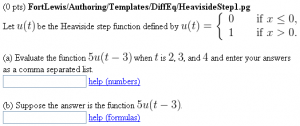Difference between revisions of "HeavisideStep1"
Paultpearson (talk | contribs) (PGML example link) |
|||
| Line 56: | Line 56: | ||
<b>Initialization:</b> |
<b>Initialization:</b> |
||
We load <code>parserFunction.pl</code> to make adding a named function to the context easier. |
We load <code>parserFunction.pl</code> to make adding a named function to the context easier. |
||
| − | Please see the POD documentation [http://webwork.maa.org/pod/ |
+ | Please see the POD documentation [http://webwork.maa.org/pod/pg/macros/parserFunction.html parserFunction.pl]. |
</p> |
</p> |
||
</td> |
</td> |
||
Revision as of 17:02, 7 April 2021
Using the Heaviside Step Function
This PG code shows how to add a the Heaviside step function step(x), which takes the value 1 if x > 0, and the value 0 if x ≤ 0, to the context. It also shows how to add a named function u(x) to the context that has a reliable answer checker and can stand in for the Heaviside step function when the student answer is a function.
- File location in OPL: FortLewis/Authoring/Templates/DiffEq/HeavisideStep1.pg
- PGML location in OPL: FortLewis/Authoring/Templates/DiffEq/HeavisideStep1_PGML.pg
| PG problem file | Explanation |
|---|---|
|
Problem tagging: |
|
DOCUMENT(); loadMacros( "PGstandard.pl", "MathObjects.pl", "AnswerFormatHelp.pl", "parserFunction.pl", ); TEXT(beginproblem()); |
Initialization:
We load |
Context("Numeric");
Context()->variables->are(t=>"Real");
Context()->functions->add(
step => {
class => 'Parser::Legacy::Numeric',
perl => 'Parser::Legacy::Numeric::do_step'
},
);
$a = 3;
$ftex = "5 u(t-$a)";
$fstep = Formula("5*step(t-$a)");
$answer1 = List($fstep->eval(t=>2),$fstep->eval(t=>3),$fstep->eval(t=>4));
|
Setup 1:
We add the step function to the context with the name For more details on adding the Heaviside function to the context, see the forum discussion on the Heaviside step function |
Context()->texStrings;
BEGIN_TEXT
Let \( u(t) \) be the Heaviside step function
defined by
\( \displaystyle
u(t) =
\left\lbrace
\begin{array}{lcl}
0 && \mbox{ if } x \leq 0, \\
1 && \mbox{ if } x > 0.
\end{array}
\right.
\)
$BR
$BR
(a) Evaluate the function \( $ftex \) when
\( t \) is \(2\), \(3\), and \(4\) and enter
your answers as a comma separated list.
$BR
\{ ans_rule(20) \}
\{ AnswerFormatHelp("numbers") \}
END_TEXT
Context()->normalStrings;
|
Main Text 1: |
$showPartialCorrectAnswers=1; ANS( $answer1->cmp(ordered=>1) ); |
Answer Evaluation 1: |
Context("Numeric");
Context()->variables->are(t=>"Real");
Context()->functions->add(
step => {
class => 'Parser::Legacy::Numeric',
perl => 'Parser::Legacy::Numeric::do_step'
},
);
parserFunction("u(t)" => "step(t)");
$f = Formula("5 u(t-$a)");
$answer2 = $f->with(
limits=>[$a-5,$a+5],
test_at => [[$a-1],[$a],[$a+0.0000001],[$a+1]],
num_points=>10,
);
|
Setup 2:
We reset the context using
Using a different method for adding functions to the context, we add the named function
Since answers are checked numerically by comparing the student answer to the correct answer at several randomly points in the domain (the default is 5 points) in an interval (the default is [-1,1]), the function
To make the answer checking robust, in
In part (b), since the students never actually see the values of the function parserFunction("u(t)" =>
"1.5 * sin(e*t) + 5*pi/3 + arctan(t)"
);
If we had defined |
Context()->texStrings;
BEGIN_TEXT
$BR
$BR
(b) Suppose the answer is the function \( $ftex \).
$BR
\{ ans_rule(20) \}
\{ AnswerFormatHelp("formulas") \}
END_TEXT
Context()->normalStrings;
|
Main Text 2: |
ANS( $answer2->cmp() ); |
Answer Evaluation 2: |
Context()->texStrings;
BEGIN_SOLUTION
Solution explanation goes here.
END_SOLUTION
Context()->normalStrings;
COMMENT('MathObject version.');
ENDDOCUMENT();
|
Solution: |
